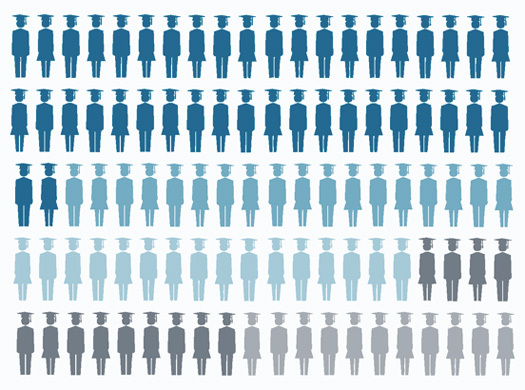
NYC schools issued 4,278 design and architecture designs in 2010 compared to 1,769 in LA, 1,552 in Chicago, 1,342 in SF, and 1,128 in Boston. Source: Center for an Urban Future.
Editors Note: Design Observer does not typically print press releases. This report, however, struck us as widely relevant to many of our readers, and so this is the full text of a press release received this morning.
Design schools may be the real engines of New York City’s innovation economy, according to a new report published today by the Center for an Urban Future, a Manhattan based think tank.
The report reveals that New York City graduates more than twice as many students in design and architecture as any other city in the country and finds that the city’s leading design schools—including Parsons The New School for Design, the Fashion Institute of Technology (FIT), Pratt Institute and the School of Visual Arts (SVA)—have become critical catalysts for innovation, entrepreneurship and economic growth.
While there has been much attention in recent months on the potential impact of a new applied sciences campus on Roosevelt Island, the Center’s study shows that the city's design universities are already playing a pivotal role in producing local start-ups. The report reveals that an astounding 129 of the 386 members (or one third) of the Council of Fashion Designers of America, a national association with members around the country, attended one of three New York City design schools: FIT, Parsons or Pratt. In addition, according to national data, nearly 20 percent of all Pratt, Parsons and SVA graduates went on to start their own businesses—a much larger percentage than design schools elsewhere.
Graduates of NYC’s design schools founded many of New York’s most visible and influential design firms, including Studio Daniel Liebeskind, Diller Scofidio Renfro, SHoP Architects, Smart Design, Ralph Applebaum Associates, Calvin Klein, Marc Jacobs and Donna Karan International.
The report, titled “Designing New York’s Future,” finds that no other city matches New York’s education infrastructure in design and architecture. In 2010, New York City graduated 4,278 students in design and architecture, while the city with the second most, Los Angeles, graduated less than half as many (1,769). New York has four design schools in the country’s top ten by the number of degrees awarded every year: the Fashion Institute of Technology (FIT) (#1), Parsons The New School for Design (#4), the Pratt Institute (#7) and the School of Visual Arts (SVA) (#10). New York City also has two architecture schools in the top ten by the number of degrees awarded: Columbia’s Graduate School of Architecture Planning and Preservation (GSAPP) (#5) and Pratt (#8).
In addition, enrollment at New York’s design universities has been growing at a faster rate than other universities in the city: Between 2001 and 2010, full time student enrollment at the city’s 10 largest design and architecture schools increased by 34 percent, going from 18,002 students at the beginning of the decade to 24,065 students ten years later. During the same period, student enrollment at all institutions of higher education in New York City grew 27 percent between 2001 and 2010. The enrollment increases at New York’s design schools also outpaced the rate of growth for other major design schools in the U.S. The largest design schools in the Association of Independent Colleges of Art and Design (AICAD), a national consortium that includes the Rhode Island School of Design and the School of the Art Institute of Chicago, grew by 28 percent between 2001 and 2010.
The report shows that New York’s leading design and architectural firms rely on graduates from these schools. According to the report, 50 percent of the designers at the Rockwell Group, a prominent design and architecture firm, are graduates of NYC design schools. At Gensler, a major design and architecture firm with more than 400 employees in NYC, an estimated 30 percent of the designers are from NYC design schools. At Nanette Lepore, the fashion house, the number is 29 percent.
While the report highlights the important role of New York’s design schools, it also shines a spotlight on areas at the schools that need improvement. For instance, the majority of the professional designers interviewed for the report said that the city’s design schools did not provide ample opportunities for them to develop business or entrepreneurial skills.
The report concludes that design universities are poised to play an even more central role in New York’s economic future given that designers are having a growing influence on everything from smart phones to the delivery of health care services. But it also faults city officials for largely overlooking design universities in their innovation economy initiatives.
The Center for an Urban Future is an independent think tank based in Manhattan that focuses on critical issues facing New York City’s future, with a focus on economic and workforce development. This study is the latest in a long line of Center for an Urban Future reports focusing on opportunities for New York City to grow and diversify its economy.
The full report is available here, as well as a one-page infographic about the report’s key findings. David Giles is the Center’s research director and author of this report.
